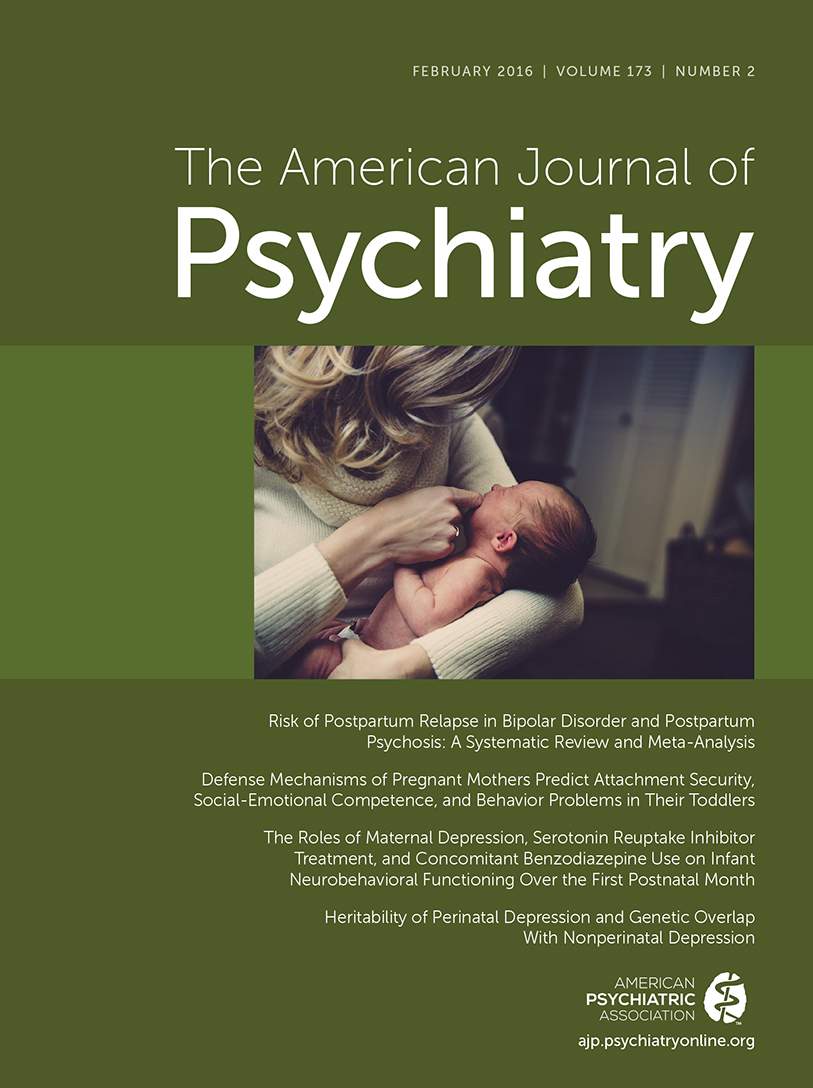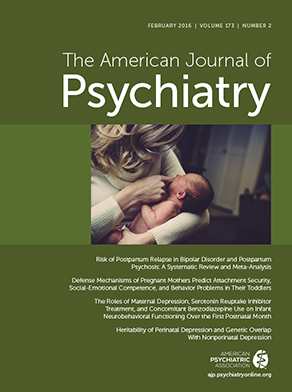During the past two decades, our awareness and understanding of the complicated nature of perinatal depression has expanded to include not only screening, symptoms, diagnoses, epidemiology, and effective treatments, but also the safety and impact of antidepressants on birth outcomes and neonates. Investigators are faced with a host of challenges when conducting studies with depressed pregnant and postpartum women, and this is particularly true when women are being treated with medications during pregnancy or breastfeeding. Many studies are limited by cross-sectional and/or retrospective design, recall bias, small sample sizes, and/or high attrition rates, as well as difficulty addressing many potential confounders such as substance use, gestational age, depression severity, timing and duration of antidepressants, and concomitant medications. Not surprisingly, clinicians, who are faced with providing patients with informed recommendations about medication use during pregnancy, are also limited by the current literature. In their article in this issue of the
Journal, Salisbury and colleagues (
1) present a thoughtfully designed and carefully described study that addresses many of these limitations to begin to better understand the complex interplay of depression and selective serotonin reuptake inhibitors (SSRIs) on infant neurobehavioral functioning in the first month of life. While it does not answer all of our questions and has its own limitations, it provides one more critical layer of understanding.
The concept of poor neonatal adaption syndrome is not new (
2). The symptoms were observed and documented over 40 years ago in relationship to tricyclic antidepressants. However, it has become more widely discussed in the literature as the use of antidepressants, especially SSRIs, has increased in the general population and therefore among childbearing age and pregnant women (
3). In most instances, studies report that these symptoms are short-term, and infants recover within 2 weeks (
4). Researchers wonder whether the symptoms are the result of exposure, toxicity, or withdrawal from these medications (
5). The study by Salisbury and colleagues explores this phenomenon and many of the confounding factors in its four-group study design comparing women who 1) do not have a diagnosis of depression and are not taking antidepressants (no exposure group), 2) have a diagnosis of depression but are not receiving antidepressants (depression group), 3) have a diagnosis of current or lifetime depression and are taking SSRIs during pregnancy (SSRI group), and 4) have a diagnosis of current or lifetime depression and are taking SSRIs and benzodiazepines during pregnancy (SSRI plus benzodiazepine group). The study is unique in its distinguishing these groups, as well as conducting repeated standardized neonatal assessments by certified blind raters at 2, 4, 7, 14, and 30 days postpartum. In addition, the authors define the criteria regarding alcohol and tobacco use and gestational weeks at delivery, confirm plasma levels of SSRIs in a subset of infants and mothers, and adjust for depression severity in the analyses.
There are many important study findings that help to address lingering questions for clinicians. First, there were no statistically significant differences between the groups with regard to birth weight, gestational age at birth, Apgar scores, neonatal intensive care unit admissions, respiratory distress, or breastfeeding within the first week postpartum. These measures are often viewed as representative of healthy birth outcomes. Second, of the 13 neonatal symptoms listed (arousal, excitability, handling, self-regulation, quality of movement, stress-abstinence signs/CNS, hypertonia, hypotonia, lethargy, attention, habituation, nonoptimal reflexes, and asymmetry), eight did not reach statistical significance between the groups in any model. Of the five symptoms that did differ at a level of statistical significance, only two remained after depression severity was added as a covariate—lower quality of movement and higher levels of CNS stress symptoms—for those in the SSRI and SSRI plus benzodiazepine groups compared with those with depression or no exposure. Third, the authors provide a unique view of the trajectory of changes in symptoms among all four groups across the postpartum month. They report, after adjusting for depression severity, statistically significant differences for the two SSRI groups compared with the depression or no exposure group at day 14 for arousal and self-regulation. An intriguing and reassuring finding is that, at day 30, there were no statistically significant group differences for any symptoms. However, the authors note a trend at day 30 for all three clinical groups, compared with the no exposure group, to show a widening difference in scores for attention and habituation that nearly reached significance. Future studies will need to incorporate repeated assessments beyond the first month to determine whether these symptom trends continue or resolve after the first month of life. Finally, the SSRI plus benzodiazepine group scores had the greatest variability within the month, as well as compared with the scores of the other three groups. The small sample size (total, N=10; completed all assessments, N=5), in addition to the greater severity of illness and comorbid disorders, must be considered carefully when interpreting these findings.
Taking into account a complete picture of these results, this study supports what we already know: the interplay of depression severity, anxiety, antidepressants, and concomitant medications in utero and postpartum is a complicated and delicate web that cannot be addressed simply. This study provides some comfort to clinicians and mothers in that many indicators of potential negative effects on birth outcomes were not more common among women who were treated with medication. While some neurobehavioral symptom differences were observed beyond the expected 14-day window, the total number was low, and they appeared to improve over the course of the month. The finding of symptom persistence beyond the first week postpartum is a crucial contribution to our understanding of the etiology of the neonatal adaption syndrome symptoms and decreases the likelihood that these symptoms are the result of medication withdrawal. With these findings in mind, it is more likely that symptoms are the result of delayed drug metabolism and/or a direct impact on infant serotonergic functioning. One of the most interesting results is that arousal symptoms were affected by depression severity. In addition, as described above, the three clinical groups (depression, SSRI, and SSRI plus benzodiazepine) showed results that fell short of statistical significance for lower scores on attention and habituation measures compared with the nonexposed group. Together, these findings lead us to question how the illness itself, as well as the severity of the illness, may affect the symptoms.
The authors suggest that this study has two important clinical implications. The first is that in their secondary analyses, they did not find differences between those women who discontinued their SSRI before the last month of pregnancy and those who remained on the medication through delivery. Therefore, they suggest that there is no need to discontinue medication in the third trimester. This recommendation is consistent with many clinical and best practices, especially for those at high risk of recurrent depression postpartum (
6). Second, the authors caution polytherapy. This recommendation has long been a mantra among those who treat pregnant women, but, as with all recommendations, it must take into account the individual’s risk-benefit analysis (
7). While not discussed or explored in this study, treatment of perinatal depression with evidence-based psychotherapy can be a “biologically safe” alternative to antidepressants. However, there are many individual and systems-based challenges for perinatal women to receive such treatment, including access to trained therapists, insurance coverage, time and childcare to attend regular therapy sessions, severity of depression, and, for some, the need for a quick onset of treatment. Furthermore, for women with a history of depression who are being treated successfully with antidepressants and who consider discontinuation and replacement with psychotherapy, they may be at risk for recurrence, which could have many other consequences.
The study has some important limitations that must be addressed in future studies. It does not address the impact of dose, pharmacokinetics, environmental influences, or long-term outcomes beyond 1 month. Importantly, it does not answer the question as to what is clinically significant or if there are ways to intervene to limit the symptoms. Future studies must explore the biopsychosocial impact of the symptoms on infants and families and address how to educate and provide mothers with concrete skills to care for infants who are experiencing such symptoms. Long-term, longitudinal, prospective studies are needed to understand the full impact of perinatal exposure to depression and its treatments.
Finally, the study results reinforce the need to treat perinatal depression. The authors’ attention to depression severity and its impact reinforce the need to treat depression while attending to the potential risks to infants. The topic of treating women with antidepressants during pregnancy remains a challenge. It is like an onion that researchers are slowly peeling and understanding each layer. This study is one more crucial step toward that understanding.

